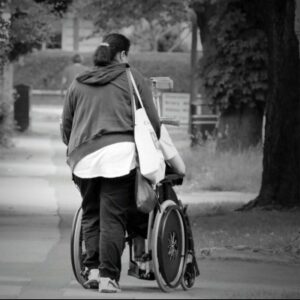 By: Stu Smith
By: Stu Smith
Over the past few months, the American public has been provided a great deal of scientific and medical information relative to COVID-19. We have learned from the nation’s best scientific minds that for the overwhelming majority of the general population, this disease presents a minimal threat to health and well being. The vast majority of healthy individuals, when infected with COVID-19, appear to experience physical symptoms, not unlike mild flu or a common cold. On the other hand, this virus can produce painful and debilitating symptoms when contracted by the elderly or those with underlying conditions. In fact, this virus has proven lethal for many in these vulnerable categories. Clearly, those suffering from chronic medical conditions, or disabilities find themselves at great risk, should they become infected. As the risk to patients requiring caregiver support escalates, the burden placed upon them has increased exponentially.
For the better part of the past 15 years, I have been my wife’s primary caregiver. She suffers from two treatable, but currently incurable, conditions. Both are potentially debilitating and life-threatening. Based upon my years of providing intense physical and emotional support for my wife, I have reached the conclusion that the most critical task in caring for a chronically inflicted patient is to attempt to create and maintain a physically safe and psychologically secure environment. This requires caregivers to remain acutely conscious of both immanent and potential threats to a well crafted secure environment. While it may be possible to neutralize all potential threats to a patient’s sense of security, one can, with due diligence, minimize or eliminate potential hazards.
My wife and I have confronted numerous threats to her physical safety and emotional sense of well-being. For example, on a trip to Wisconsin for surgery, an airline attendant recklessly destroyed her wheelchair, leaving us stranded without this specially designed piece of necessary equipment. On many other occasions, neurological issues left her comatose and dangerously close to losing her life. We were able to overcome these threats to her life and the additional emotional trauma of her possibly being confined to a wheelchair for life. We faced these challenges with all the courage we could muster. We would also face our fears and hopes together with many tears shed in the process. She is now walking considerable distance and her most recent neck surgery appears to have eliminated any immediate threat to her life.
I certainly do not consider myself an expert in the field of caregiving. I am just an ordinary guy driven by unforeseen circumstances into the role of long-term caregiving. The source of my understanding as to what I consider the critical essence of this demanding task is 15 years of direct experience. The coronavirus presents a new and dangerous threat to the health and safety of both caregiver and patient, particularly if they are both advanced in age. With this challenge presented by this new pandemic, I, along with the millions of other family caregivers, must apply all we have learned to resist this new potentially existential threat.
While there are many aspects of caregiving, such as assisting with basic physical needs, which are obvious, there also exist elements of caregiving that are much more nuanced and thus less obvious to the layperson. Depending upon a patient’s condition, care can prove physically and emotionally exhausting. Indeed, intense caregiving may prove to be an emotional endurance test. One might compare long term caregiving to a roller coaster ride that includes high anxiety without the enjoyable thrills and excitement.
As a result of the physical and emotional pressures involved in caregiving, it is critical that the caregiver make the effort to maintain his or her own physical health and emotional equilibrium. It is essential that the caregiver find the time to focus on self-care and not find oneself embracing the role of martyr. This will only diminish an individual’s long term health and wellbeing, thus limit his or her capacity to provide productive long-term care.
The chronically ill or disabled, quite understandably, often perceive the world as a threatening environment. This should not be viewed as an unhealthy paranoia, but instead, a justifiable fear based upon very real threats to a patient’s health and psychological wellbeing. Individual patients with physical limitations and heightened emotional sensitivities are very vulnerable to everyday activities. For instance, they may slip on an icy sidewalk causing a setback in their treatments. This can then take many months to then correct.
This virus is presenting those with compromised immune systems and other risk factors with an extreme threat. The emotions of fear, anxiety, frustration, and anger must be dealt with and somehow overcome if we as caregivers and patients are to maintain a sense of security and emotional wellbeing. At times like these, I always attempt to keep the following quote active in the forefront of my consciousness: “We walk this path together and if you stumble, I will take your hand and if I tremble, you will hold me tight as all is not lost.”
Try to stay safe, take care of yourself, and may life be kind to you.
 Stuart Smith is the co-director for Medical Cannabis Advocacy for U.S. Pain Foundation, along with his wife, Ellen, who lives with two rare conditions. Stu has and continues to be Ellen’s caregiver and together, they raise awareness surrounding invisible pain and the effectiveness of medicinal marijuana for pain patients.
Stuart Smith is the co-director for Medical Cannabis Advocacy for U.S. Pain Foundation, along with his wife, Ellen, who lives with two rare conditions. Stu has and continues to be Ellen’s caregiver and together, they raise awareness surrounding invisible pain and the effectiveness of medicinal marijuana for pain patients.
Ellen and Stu live in Rhode Island with Ellen’s service dog Maggie and have raised four sons and enjoy their five grandchildren.
